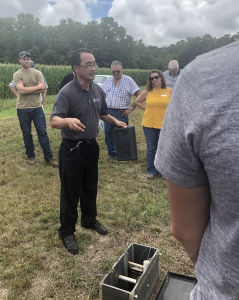
Man-made per- and polyfluorinated substances (PFAS), known as “forever chemicals,” withstand many treatment options and bioaccumulate in the environment, posing serious environmental and health concerns. With a three-year, nearly $1 million grant from the U.S. Department of Defense (DOD) Strategic Environmental Research and Development Program (SERDP), Illinois Sustainable Technology Center (ISTC) scientists are developing a new technology to remove and destroy PFAS from contaminated water using a designer biochar produced from woody biomass or agricultural residues such as corn stalks and cobs.
PFAS are a widely used class of chemicals found in many different consumer, commercial, and industrial products, including non-stick coatings and textiles. Since the 1970s, PFAS have also been used in firefighting foam, which is why the DOD is interested in finding new solutions to clean up contaminated sites where firefighters have trained, according to Wei Zheng, principal investigator of the project at ISTC, a unit of the Prairie Research Institute at the University of Illinois Urbana-Champaign.
Activated carbon, as a most common adsorbent, is typically used to treat PFAS-containing water. Once the activated carbon is saturated with the contaminants, the spent adsorbent is incinerated. However, incineration, even done at sufficiently high temperatures, cannot completely destruct PFAS and will create some hazardous and toxic byproducts. In 2022, the Office of the Assistant Secretary for Defense placed a temporary ban on incineration of materials containing PFAS until safe guidance for disposal of PFAS is issued.
“If incineration is not an option, the spent adsorbent ends up in the landfill where PFAS can leach to water sources and evaporate to air because they won’t degrade,” Zheng said. “So, PFAS will go back to the environment. In this way we just solve one issue but generate a new problem.”
In addition, wastewater treatment plants can’t solve the PFAS issue because these contaminants are never destroyed by conventional treatment techniques. That is why they are called forever chemicals.
In the new project, Zheng will develop a hydrothermal technology, likened to pressure cooking, that will destroy PFAS absorbed on low-cost designer biochar created at ISTC, and at the same time reactivate the biochar that has reached its sorption capacity for reuse. Thus, the designer biochar will act a double role as an adsorbent to remove PFAS from contaminated water and as a catalyst to destroy these compounds under a hydrothermal system.
“The most important and innovative aspect of the project will be the complete destruction of PFAS once they are removed from the water,” Zheng said. “PFAS are widely detected in the environment and in the atmosphere. Our project is designed to mitigate human exposure to PFAS, helping to find ways to indeed solve this problem.”
ISTC is collaborating with researchers at the U.S. Army Corps of Engineers Construction Engineering Research Laboratory on this project.
—-
Media contact: Wei Zheng, 217-333-7276, weizheng@illinois.edu
news@prairie.illinois.edu




 Woodchip bioreactors, which are buried trenches, have proven to be a cost-effective and sustainable solution to reduce nitrate-nitrogen loss from tile-drained crop fields. However, concentrations of ammonium-nitrogen are often elevated after water has flowed through a bioreactor. Also, woodchip bioreactors do not have a significant effect on phosphorus removal.
Woodchip bioreactors, which are buried trenches, have proven to be a cost-effective and sustainable solution to reduce nitrate-nitrogen loss from tile-drained crop fields. However, concentrations of ammonium-nitrogen are often elevated after water has flowed through a bioreactor. Also, woodchip bioreactors do not have a significant effect on phosphorus removal. The filter holds biochar—a biomass product that looks like charcoal and is made mostly of carbon with high calcium and magnesium—which traps fertilizer nutrients. The biomass is made into small pellets that won’t block water flow.
The filter holds biochar—a biomass product that looks like charcoal and is made mostly of carbon with high calcium and magnesium—which traps fertilizer nutrients. The biomass is made into small pellets that won’t block water flow.


 Join us on May 21-22 for the
Join us on May 21-22 for the